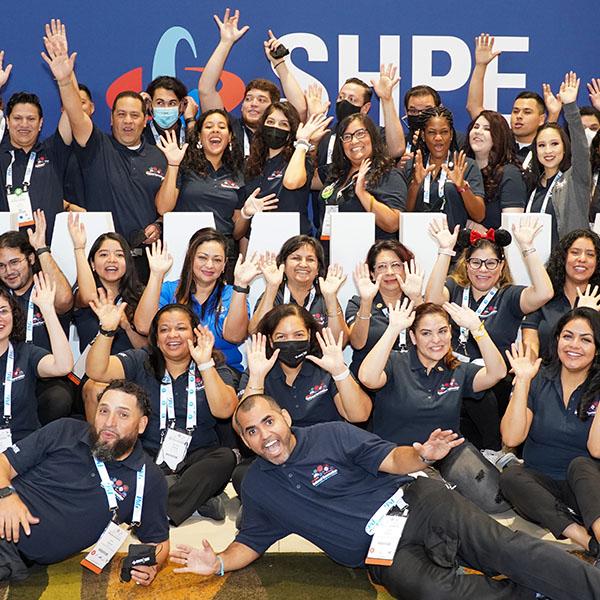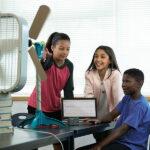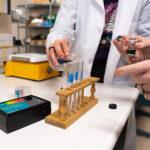
Sharing ideas and inspiration for engagement, inclusion, and excellence in STEM

The mission of the Society of Hispanic Professional Engineers (SHPE) is to “change lives by empowering the Hispanic community to realize its fullest potential and to impact the world through STEM awareness, access, support, and development.” We recently sat down with the organization’s chief research and innovation officer, Dr. Kimberly Douglas, to discuss the current state of—and actions being taken to increase—Latino representation in STEM. The interview has been edited for length and clarity.
How would you describe the state of Latino representation in STEM today?
Over the past number of years, we’ve made progress, but we haven’t made as much progress as is needed. In 2021, 18 percent of the US workforce was Hispanic. But if you look at both engineering and STEM, we were much less represented in those spaces. In STEM occupations, Hispanics made up 8.2 percent. For engineering, it was 8.9 percent.
It’s projected that by 2030, 11.3 million of the jobs in the US will be related to STEM. That’s a 10.5 percent growth, as compared with a 7.5 percent growth for non-STEM jobs. So, you put that together, and then you think about the fact that Hispanics represent the largest increase in terms of population growth—if we’re really going to meet those demands in terms of the STEM jobs that are needed, we are going to have to draw more Hispanics into STEM careers.
What are some ways educators, education administrators, and professional organizations can help increase the representation of Latino students and professionals in STEM?
Whether students are in K–12 or college, seeing people who look like them in the front of the classroom makes a difference.
If Hispanic STEM majors decide not to pursue STEM, it’s important that they see K–12 education as a viable career option. At SHPE, we’ve thought about creating programming that’s centered around, “Well, if I decide that the major I’m in is not right for me, how do I think about other options before I go to something that’s completely outside of STEM?” The K–12 educator path could be an option for those students. They already had some exposure to STEM, and they had that passion for it because they started out as STEM majors— can we refocus that passion so that it can make a difference for kids?
In terms of college educators, again, it’s a matter of having Hispanic students see role models who are really enjoying their careers so that they can see themselves in that role. At SHPE, we’re launching a Future Grads program, which will support our undergraduates in considering going on to graduate school and then supporting that application process. The point is that we have to have more of our undergraduates go on to earn advanced degrees. You need an advanced degree to be a college STEM educator, but it’s also needed for many research paths that are in the STEM industry.
Generally speaking, whenever I think about encouraging more Hispanics to pursue STEM majors and professions, I think about the programs we build at SHPE that address three key barriers that we see for Hispanics in STEM: affordability, belongingness, and role models.
#1: Affordability. How can we have more scholarship support to help Hispanic students go to college? Also, how can we help them have jobs that are related to building their STEM identity? We know that many of our students work more than 30 hours a week while they’re trying to get a STEM degree, and those two things are at odds. That’s why many will end up going to school part time, which means it takes them longer to graduate. We need to work toward these students having employment that’s related to their major while they’re going to school—and that gets to the affordability piece.
#2: Belongingness. Do I belong here? Do I fit in here? Much of what SHPE does through our chapters is really give our members that sense of familia, that sense of connection, that sense of interacting with someone with similar goals who looks like them and is like them with whom they can build community on their campus.
#3: Role models. At SHPE, we’re doing more and more work to create resources that educators can use to showcase Hispanics in a variety of STEM roles. In the K–12 space, some of our programming is centered around having kids do hands-on activities while hearing from someone whose job relates to those activities and having that person share their passion for their work.
What other programs does SHPE offer to help support Latino students’ access to and success in STEM?
One of the programs that we’re currently delivering that I’m most excited about is called Equipando Padres, which means “equipping the parents.” For many, the essence of Latino culture or Hispanic culture is the family; parents, grandparents, aunts, and uncles are such a critical support system for many Hispanic students.
When students are in the pre-college space, their family is usually able to provide them with support. But the majority of our Hispanic students are first-generation college students; when they get to college, they don’t have that same support system. Their parents and other family members can continue to provide emotional support, but they don’t know how to help the student navigate the path to getting a degree.
With Equipando Padres, we’re essentially equipping the parent to be able to provide that instrumental support—helping them understand what it’s like to get a college degree and having them walk the path with their child in earning that degree. We’re equipping them to be able to actively engage in decisions the student makes along the way, if the student wants them to.
How can education technology companies, such as Vernier Science Education, help support Latino students’ access to and success in STEM?
When we went to build Equipando Padres, one of the things we found is that if you look for that type of programming nationwide, resources are very difficult to find. And when you can find them, if they’re available in Spanish, they are translated, not written in Spanish—and there’s a difference. When you have a conversation with someone who speaks another language, the words don’t just translate directly. And if you use a translation website, it’s not the same thing.
When I think about the types of resources that Vernier Science Education creates, as much as possible, being able to have those available in both English and Spanish—and written in Spanish—can make all the difference in the world. It shows the student, as well as their family, that you value their culture.
We have a wide range of Spanish-speaking levels in the Hispanic community nationwide. But when you think about those who have the least access and are the most disadvantaged, they will often have people supporting them whose primary language is Spanish. I think being able to help create that bridge to make it a more inclusive educational environment is the thing that is most needed.
Do you have any concluding thoughts?
To all the educators out there, thank you for everything you’re already doing. At the same time, I would ask that you take an additional step and be more purposeful in encouraging your Hispanic students to think about how they might take the next step in their educational journey. That type of encouragement can be the spark that makes all the difference.
Share this Article

Sign up for our newsletter
Stay in the loop! Beyond Measure delivers monthly updates on the latest news, ideas, and STEM resources from Vernier.






